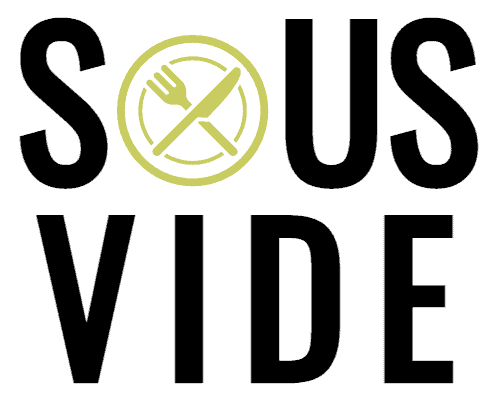Steak is one of the most popular food choices when cooking sous vide, and for good reason. While other methods require careful attention and crafted technique to prevent overcooking or undercooking, with little effort a sous vide steak comes out perfectly every single time.
When you experience the beauty of sous vide steak, there’s a good chance you’ll skip the fancy steakhouse since you know you can cook your steak as well, if not better than the restaurant will!
But with so many cuts of steak out there, what is the best steak for sous vide cooking? It can get confusing when you’re standing at the meat counter with so many different options.
Let’s go steak cut by steak cut to find out the details of various steaks and how to cook each one. We generally guide to cooking to a medium rare steak temp.
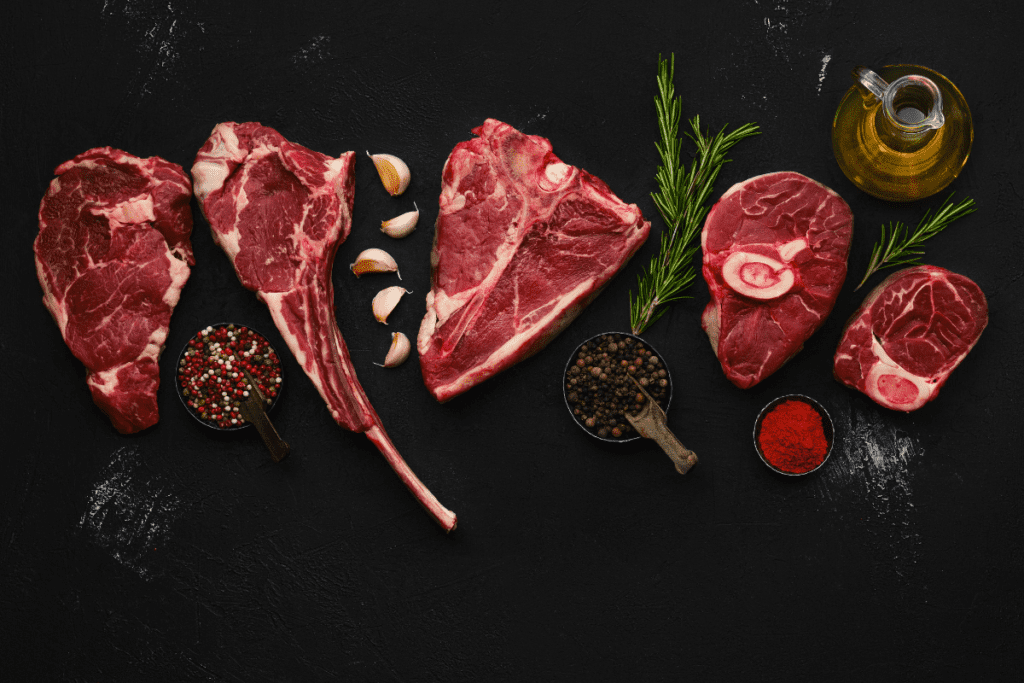
Table of Contents
Best Sous Vide Steak Cuts
Filet Mignon
Other Names: Beef Tenderloin Steak, Tender Steak
The Filet Mignon is the most tender cut of steak, while still being lean. The tenderloin filet is the among the most expensive steak cuts, but offers a melt in your mouth texture.
Sous vide cook it for 2 hours at 127ºF / 52.8ºC temperature for a borderline rare+ medium-rare center that’s juicy and delicious. Bump the temp up for more doneness. This is a lean steak with mild flavoring, which can overcook easily.
- Related Recipes: Sous Vide Filet Mignon
- Sous Vide Tenderloin
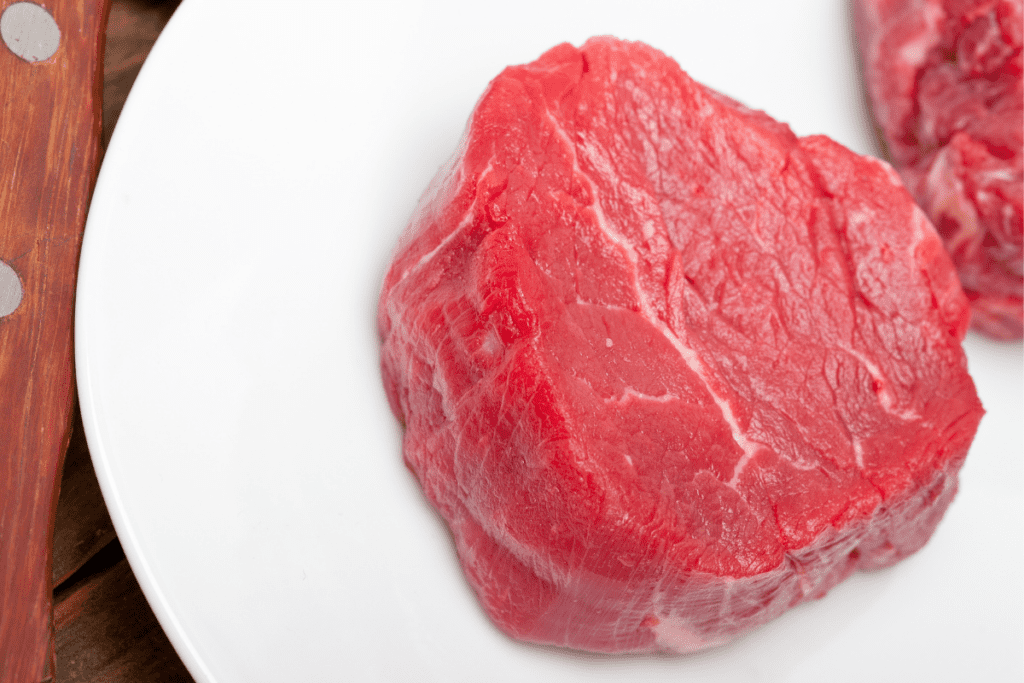
If you like your cuts blue rare, a filet is the best cut. You can read more about why in our post on blue rare steak here,
Ribeye Steak
Other Names: Scotch Filet, Beauty Steak
The juicy and full flavored Ribeye is a highly popular cut among meat connoisseurs and everyday chefs alike. It can be served boneless or bone-in, with the bone-in variety commonly nicknamed the “cowboy cut” in American restaurants.
The high marble and rich fat content found in Rib eye steaks gives it a looser grain that results in a tender, rich and buttery texture once cooked. The Ribeye is my favorite cut of steak to sous vide.
Cook your Ribeye steak in a sous vide water bath at 129ºF / 53.9ºC for 2 hours.
- Related Recipe: Sous Vide Rib Eye
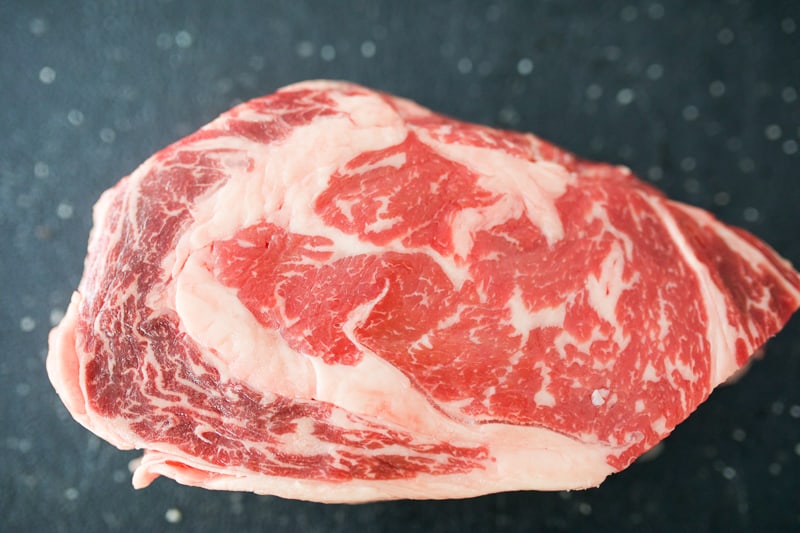
Bone in ribeye goes by the name tomahawk steak, cowboy ribeye, and rib steak.
New York Strip Steak
Other Names: Shell Steak, Kansas City Steak
Cut from the short loin of the cow, the New York Strip Steak comes from muscles that don’t do too much work. That makes it one of the most tender cuts of meat you can find, only second to the Tenderloin.
Typically served boneless, the lean muscle fibers present in a New York Strip Steak cook evenly and quickly. You get a great beefy flavor with great texture, especially when prepared via sous vide.
Cook New York Strip Steaks at a temperature of 130°F / 54.4ºC for 2 – 4 hours.
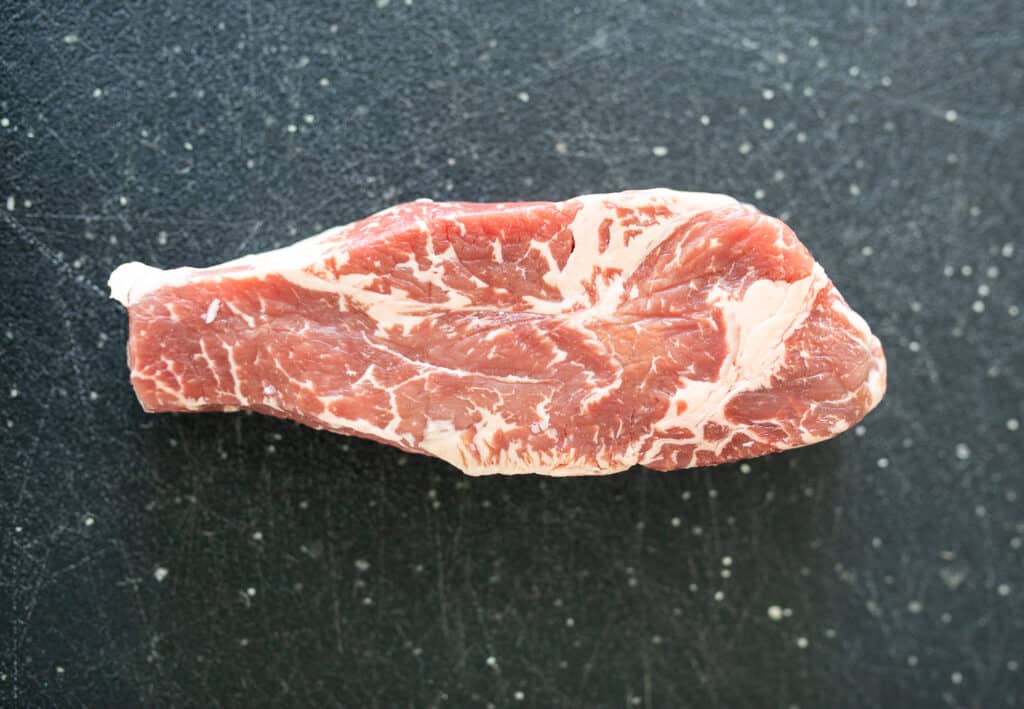
- Related Reading: New York Strip vs Ribeye – Which to Choose?
Porterhouse Steak & T-bone Steak
Other Names: Date Steak
This is a two for one because both steaks have the same components.
Fans of the TV show Seinfeld will probably find this name familiar – T-Bone.
The T-Bone steak is a giant cut of steak – enough for 2 people or a very hungry person. This cut combines a New York Strip and delicate filet mignon separated by a T-shaped bone in the middle – hence the nickname T-bone. It’s packed full of great beefy flavor and has a perfect tenderness.
For a Porterhouse, the perfect sous vide cooking temperature is 131ºF / 55ºC for 2 hours for a juicy medium rare center that is still pink.
Read this to understand the difference between Porterhouse vs T-bone.
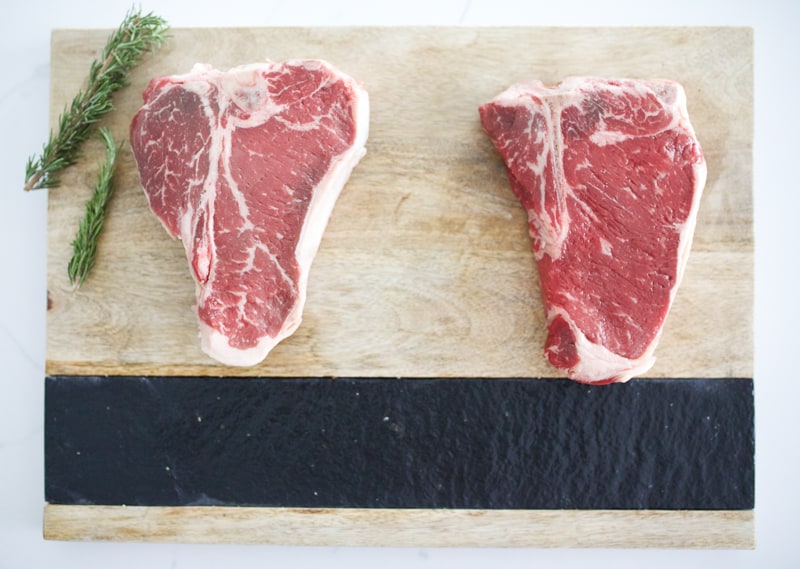
Prime Rib Steak
Other Names: Standing Rib Roast
Compared to the Ribeye, the Prime Rib steak cut contains more bone, fat and connective tissue as it is a larger roasting cut. This results in more complex flavors present in the Prime Rib.
Since the cut itself is so tender already, a sous vide cooking temperature of 131ºF / 55ºC is just perfect for a nice medium rare center.
- Related Recipe: Sous Vide Prime Rib
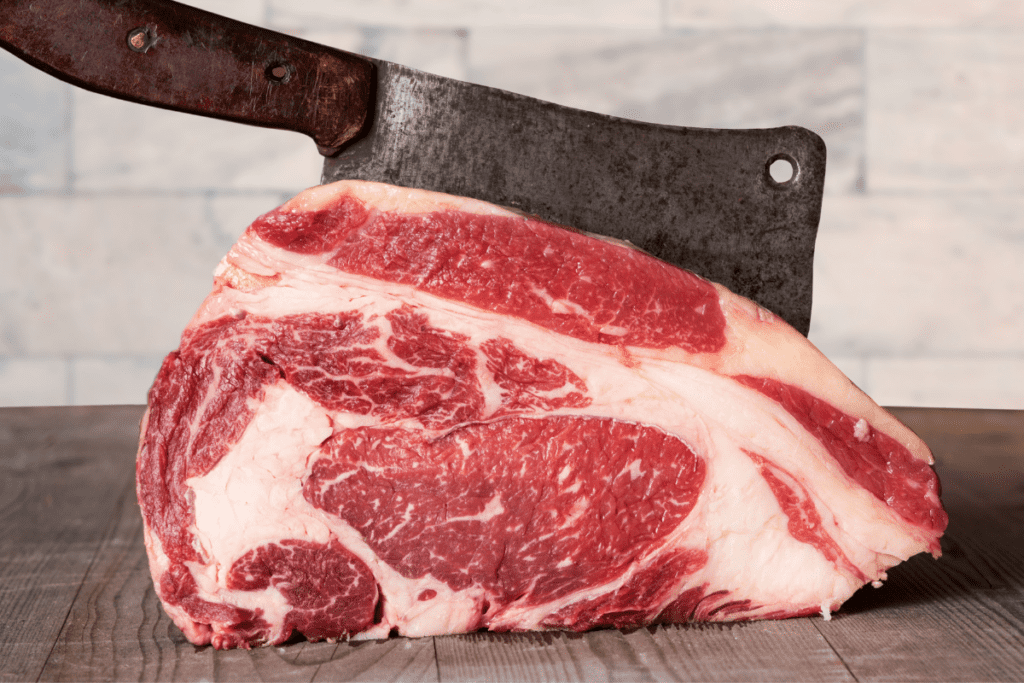
Sirloin Steak
Other Names: Top Sirloin
The Sirloin is lean and full of juice and flavor. Moderately tender with no bones present and very little fat makes it good for both grilling and frying.
The Sirloin also provides excellent value for money for those looking for a quality cut at an affordable price.
At 131ºF / 55ºC water bath temperature, cook your sirloin for 2-4 hours and finish it off with a quick, high-heat sear on each side with a kitchen torch.
- Related Recipe: Sous Vide Sirloin Steak
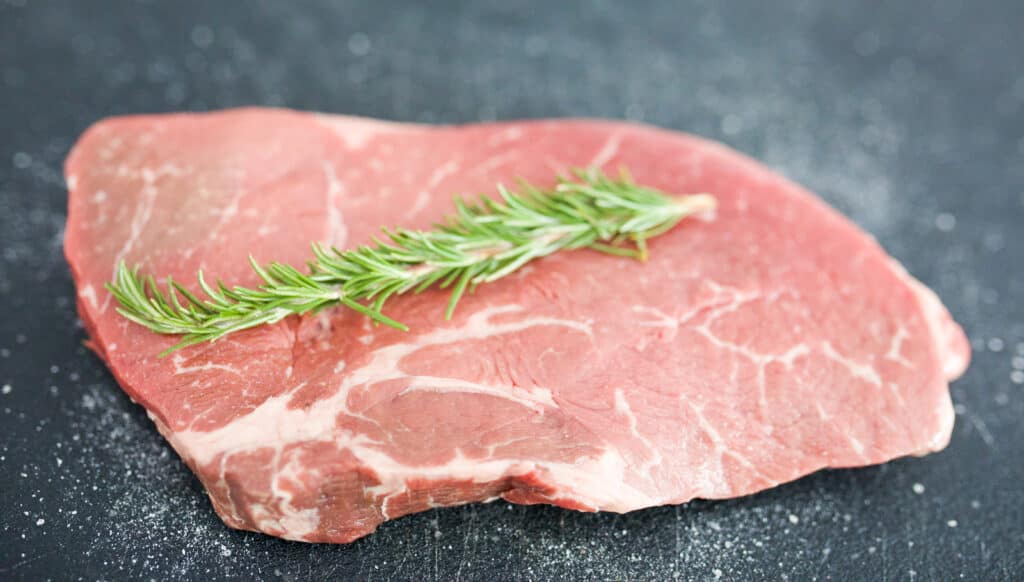
Hanger Steak
Other Names: Onglet, Butcher’s Cut, Hanging Tender
Known as onglet in France, it’s a highly popular cut of steak prepared in most French brasseries. The hanger cut isn’t one of the more well-known cuts of the cow, but you can ask your butcher for it.
When at the butcher shop, the savory flavor and tender qualities of this cut is astonishing and because it isn’t as popular as the other more well-known portions of the cow, you can afford to spend relatively little for maximum payoff – if you cook it right.
To sous vide your hanger steaks, go for 130ºF / 54.4ºC water temperature and set the timer for 2 – 4 hours.
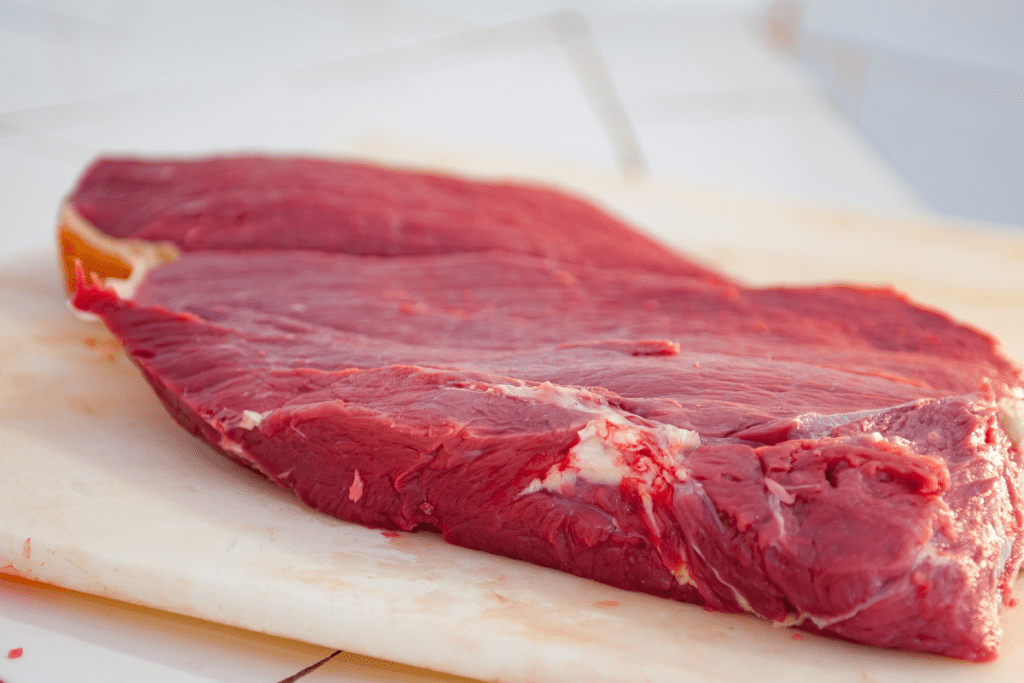
Flank Steak
Other Names: London Broil
The Flank Steak, found in most fajitas recipes, is sinewy and full of hardworking muscle fibers that can sometimes be tough to chew on. The texture from the flank steak can make it difficult to prepare, which gives it an attractive affordability factor.
However, sous vide (or similarly braised) Flank Steak can produce a large number of servings that makes it perfect for the buffet table.
Sous vide your Flank Steak at a temperature of 132ºF / 55.6ºC for 1.5 hours for an inch thick cut, or 2.5 hours for a thicker cut.
- Related Recipe: Sous Vide Flank Steak
- Related Recipe: Steakhouse-Style Sous Vide London Broil Recipe
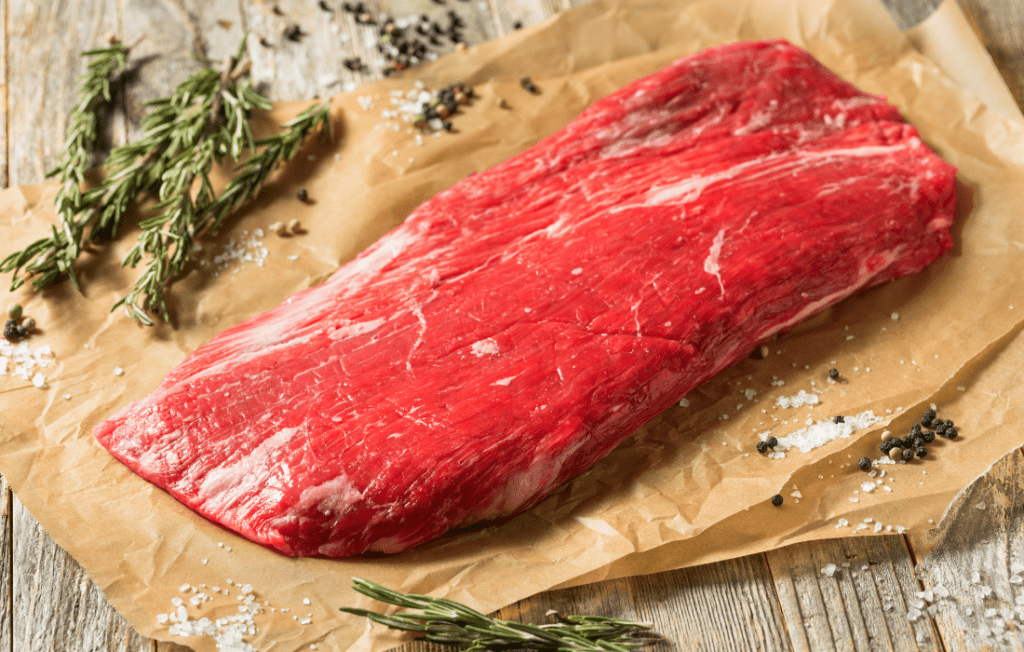
Skirt Steak
Other Names: Philadelphia Steak
This is the go-to choice for carne asadas because of its robust flavor profile with nice marbling. It’s just as savory as a Ribeye at a fraction of the price. A quick marinade is a great way to amp up the flavor of the Skirt Steak.
Sous vide cooking your skirt steaks at 130ºF / 54.4ºC for 2 hours will yield terrific tasting medium rare steaks.
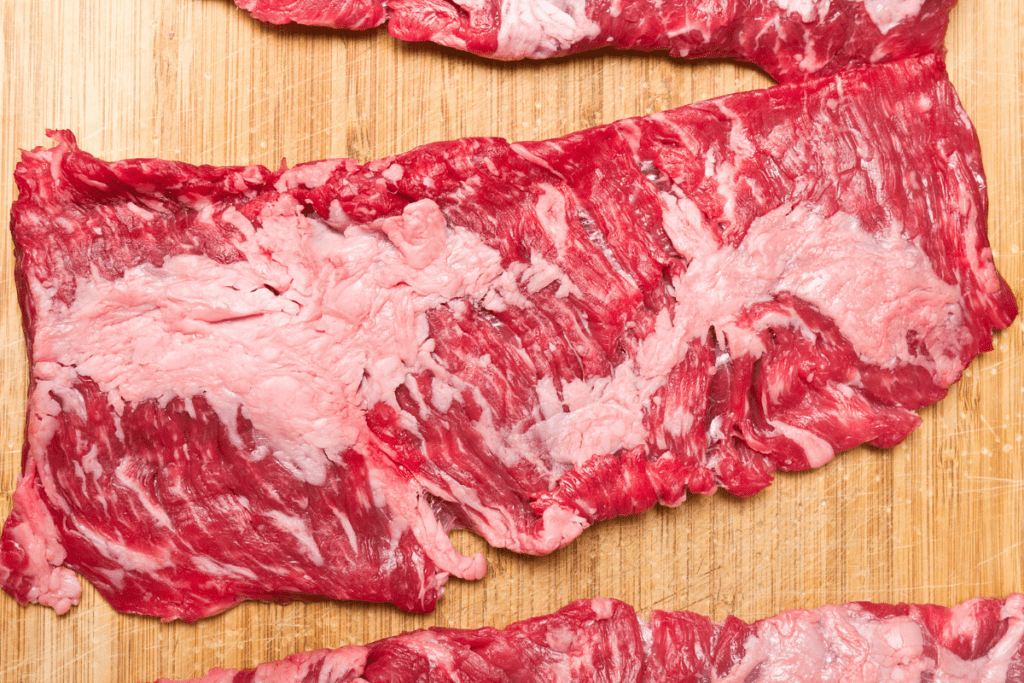
Flat Iron Steak
Other Names: Top Blade Filet
The Flat Iron Steak is cut from the shoulder, or “chuck” of the cow. It’s tender and marbled, with rich flavor, and the cut itself is of a uniform thickness and shape. The flat iron steak only needs a simple marinade and takes on the flavors of the ingredients it’s combined with for a great taste experience.
Sous vide your Flat Iron Steak at 135ºF / 57.2ºC for 2 hours for a juicy, tasty medium rare doneness.
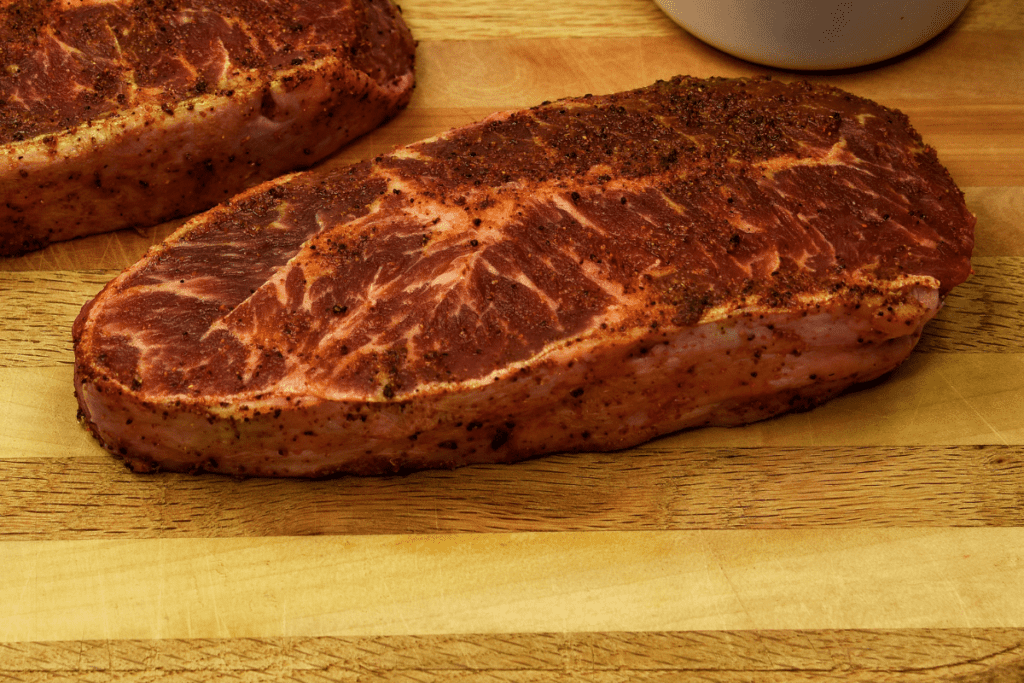
Criteria to Consider When Buying a Steak to Sous Vide
Ideal Thickness
The tenderness of and cook time for your sous vide steaks will depend on the thickness of the cut you use. In general, 1.5 inches is the ideal thickness for steaks cooked following the time and temperature chart above.
If you have a sous vide steak thicker than 2 inches, a good rule of thumb is to add an extra hour of cooking time per inch.
Marble
Meat with more marble delivers a more robust and rich flavor compared to leaner cuts. Look for a happy middle ground between lean and fatty cuts to get the best of both worlds.
If you are looking for the most marbled cut of steak, which is also among the world’s most expensive steaks, try the famous Japanese Wagyu. Kobe beef is a type of Wagyu. Wagyu is the best marbled out there because of the way the Japanese grow and feed their prized Wagyu cattle. Wagyu are bred to be 50% fat, so it’ll literally melt-in-your-mouth.
- Check out the Recipe: Sous Vide Wagyu Steak
Price
Unless you’ve got a huge bankroll to spend at the butcher shop, be conscious of the prices you pay for the premium cuts. Don’t think that the more money you pay, the better the sous vide steak will be. You might just get better value out of a cheaper section if you know how to cook it right.
There are still other cuts out there like short ribs, chuck roast, and round steak you can try. You can even sous vide frozen steak if you have it.
Where to Find Quality Steaks For Sous Vide Cooking
The cuts described above are common cuts that can be found at your local butcher or grocery shop.
If you haven’t tried ordering online at Crowd Cow, I’d encourage you to do so. They have a large selection of high-quality meats and operate under the core tenents of taste, transparency and convenience. Use this link for $10 off your first Crowd Cow order.
Crowd Cow connects you to 100+ small farms across 23 states. The selection ranges from competitively priced grocery store staples to restaurant quality craft and heritage meats.
Abbreviated Instructions to Sous Vide Steak
In case helpful, below is an overview of the steps to follow to execute high quality sous vide steak.
1. Preheat – Set Your Sous Vide Time and Temperature
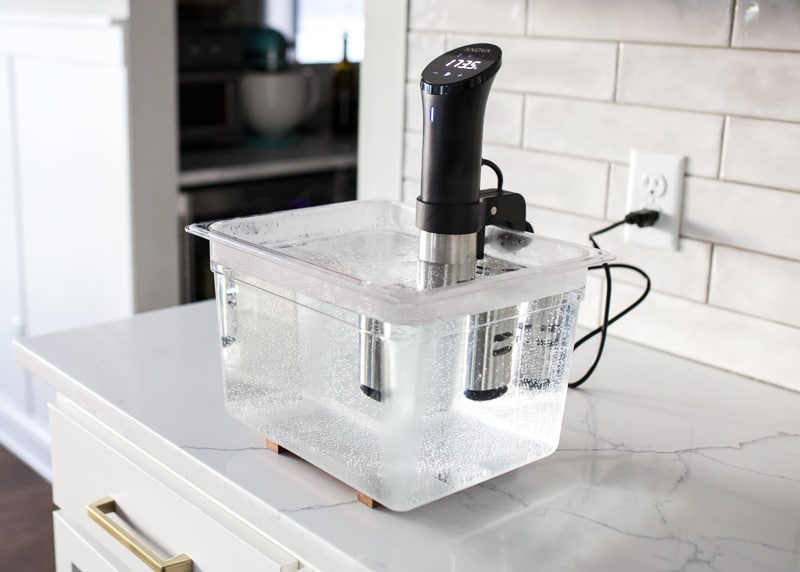
Fill your container (can be as simple as a big pot) with water and set your immersion circulator up according to its specifications. Find the appropriate time and temperature for what you are cooking.
The temperature will correspond to the internal temperature you desire (perhaps minus a few degrees to accommodate for the sear). The time will vary based on the density and thickness of that which you cook.
Use the time and temperatures noted above for each cut.
2. Season Your Food
Like any other method of cooking, seasoning is the crucial first step to producing a delicious dish. Immersion cooked dishes benefit from the seasoning being pressed right up against the main ingredient and ultimately immersed in the juices in low and slow fashion, which enhances the flavor.
3. Bag It (perhaps with herbs, lemons, etc.)
Place your seasoned food into the sous vide bag. Use either a food grade vacuum sealing bag, a plastic Ziploc like freezer bag, or a silicone Stasher like bag. Including aromatics like sprigs of thyme or rosemary will produce big flavor.
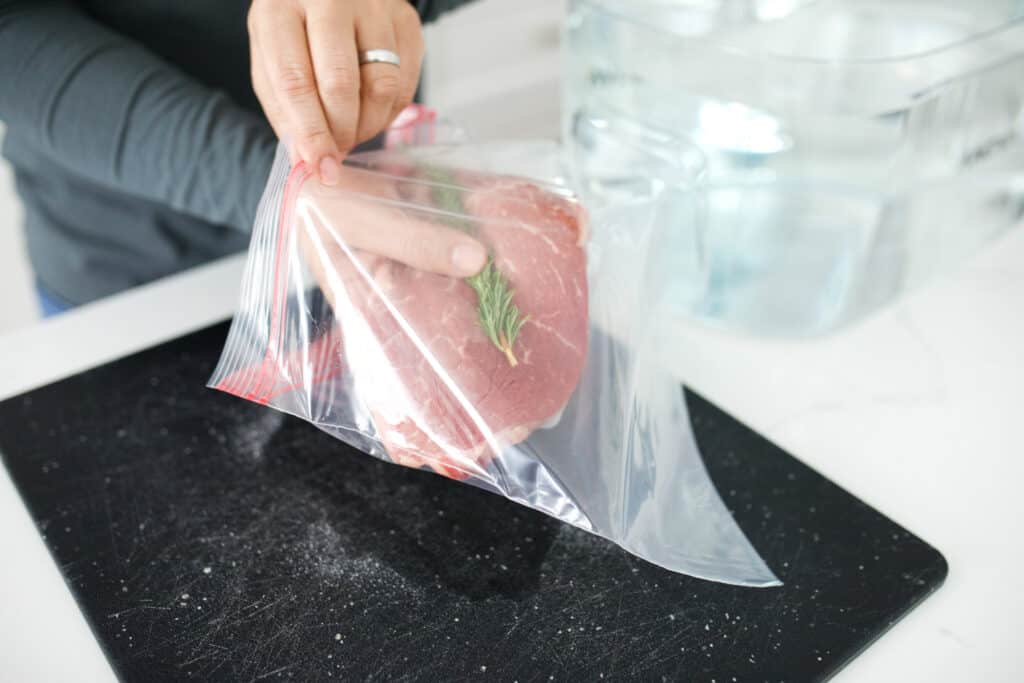
4. Seal the Sous Vide Bag
This is the crucial step where things can go sideways if not performed carefully. The objective here is to remove as much air as possible from the sous vide bag so that the food is essentially immersed in the water without an air barrier whatsoever.
Vacuum sealed bags make this step a breeze. For Ziploc and Stasher type bags you’ll want to use the water displacement method.
Press as much air out of the bag containing your food as you can and seal it almost all the way just so air can escape. Now, lower the it into the water to displace the remaining air out of the bag and then completely seal on the follow. Be careful not to allow any water to enter the bag.
*Find our favorite vacuum sealer here!
5. Cook By Sous Vide
Simply clip the seal-side up bag (e.g. with a clothes pin or binder clip) to the container so that it is fully immersed.
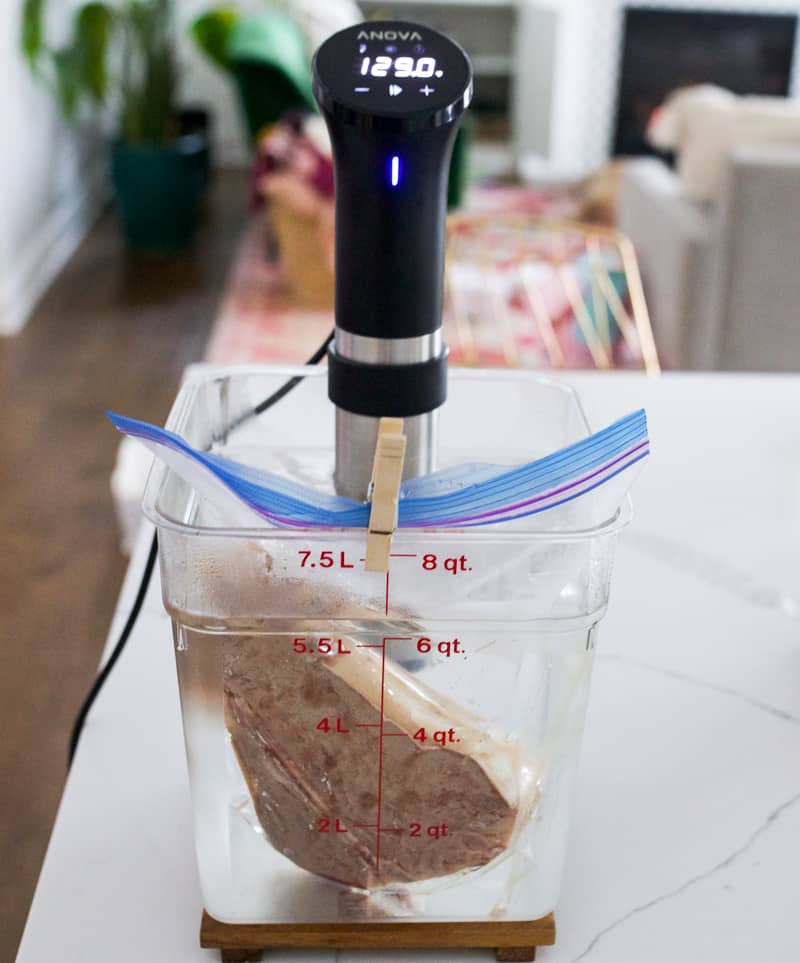
If you use vacuum sealed bags, clipping isn’t necessary, but you’ll want to make sure the bags remains fully immersed. A rack or weights can be helpful here.
6. Sear Sous Vide Steak
Searing is critical to having your steak be plate ready. Not only does the searing process add color to the dish, but also adds depth of flavor, texture and locks in juices.
The critical steps to get a great crust are:
- Dry the steak thoroughly by patting it with a paper towel
- Season the steak generously with seasoning such as salt and pepper
- Use extremely high heat – a cast iron pan, outdoor grill, or searing torch are good options
Be careful not to overcook in this final step. Flipping often (e.g. every ~30 seconds) can help avoid overcooking; This should not take long.
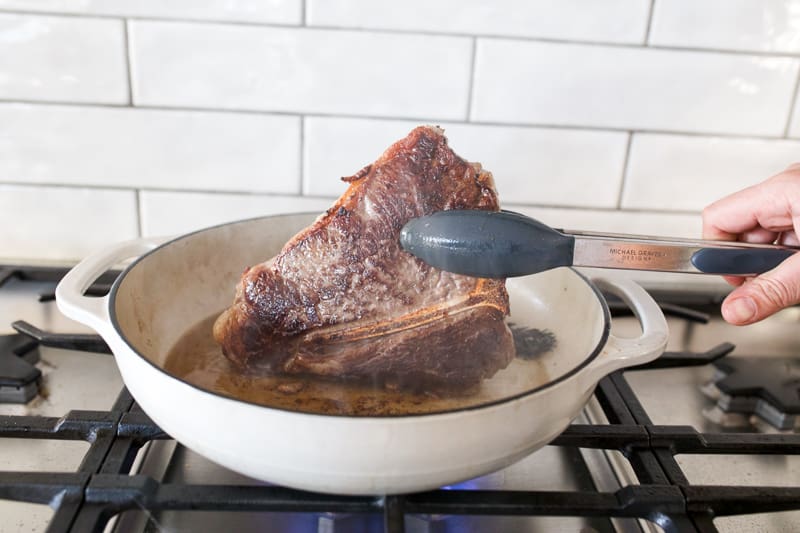
We’re looking to preserve the perfectly even doneness of the sous vide steak, while adding color, texture and taste to further its appeal.
7. Serve Sous Vide Steak
Now you’re ready to hit it with some salt and plate it!
Sous Vide Device
If you’re new to immersion cooking, the only critical item you need to prioritize is the sous vide cooker. It’s a portable machine that clamps onto a container to circulate, heat and regulate water to the desired temperature.
Immersion circulators include the Anova Sous Vide Precision Cooker series and the Breville Joule Sous Vide Cooker. For a more complete comparison of immersion circulators see our review of the 10 best sous vide machines.
Steak Sous Vide FAQs
Where you’ll notice the biggest difference between preparing steak sous vide versus other methods is on tougher cuts of steak. Tougher generally translates to cheaper, but doesn’t mean worse by any means.
Sous vide is excellent at breaking down tough cuts and tenderizing them. I’d put cuts such as flank, tri tip, short ribs and top round in the tough steak category that cooks wonderfully in a sous vide.
That said, if you already have a favorite cut of steak, that’s the best one to cook sous vide. The beauty of sous vide is the predictability of the end product. Your favorite cut will be cooked perfectly every time.
Animal protein in general works great in sous vide. Beef, pork and lamb are prime candidates. The tougher the meat, the more the sous vide will shine against other cooking methods.
All beef cuts are good for sous vide. The predictability of the outcome is the key here. As long as you use the appropriate temperature and time, which in itself generally has a lot of flex with a sous vide, you’ll maximize the potential of your steak or roast. Searing is the key final step you must not omit.
YES, sous vide steak IS really that good. If not, you used the wrong time and/or temperature. The consistency and flavor profile, created by the constant bathing of the steak in its own juices, is unparalleled. You must sear steaks to bring it all together.
Hungry yet? Grab your sous vide machines, containers, vacuum sealers, plastic bags, kitchen torches, and other sous vide tools and get cooking!
If you’re looking for more recipes, check these out:
